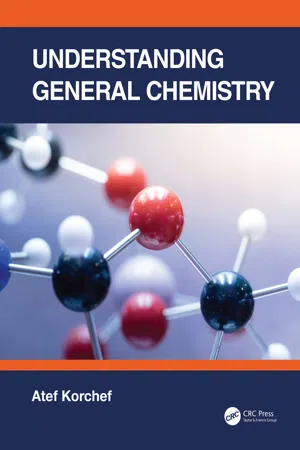
Understanding General Chemistry
Atef Korchef
- 266 pages
- English
- ePUB (mobile friendly)
- Available on iOS & Android
Understanding General Chemistry
Atef Korchef
About This Book
Understanding General Chemistry details the fundamentals of general chemistry through a wide range of topics, relating the structure of atoms and molecules to the properties of matter. Written in an easy-to-understand format with helpful pedagogy to fuel learning, the book features main objectives at the beginning of each chapter, get smart sections, and check your reading section at the end of each chapter. The text is filled with examples and practices that illustrate the concepts at hand. In addition, a summary, and extensive MCQs, exercises and problems with the corresponding answers and explanations are readily available.
Additional features include:
-
- Alerts students to common mistakes and explains in simple ways and clear applications how to avoid these mistakes.
-
- Offers answers and comments alongside sample problems enabling students to self-evaluate their skill level.
-
- Includes powerful methods, easy steps, simple and accurate interpretations, and engaging applications to help students understand complex principles.
-
- Provides a bridge to more complex topics such as solid-state chemistry, organometallic chemistry, chemistry of main group elements, inorganic chemistry, and physical chemistry.
This introductory textbook is ideal for chemistry courses for non-science majors as well as health sciences and preparatory engineering students.
Frequently asked questions
Information
1 Matter
1.1 Objectives
- Define the states of matter and compare their properties.
- Differentiate between the types of matter (elements, compounds, mixtures).
- Differentiate between chemical properties and physical properties.
- Differentiate between chemical change and physical change.
1.2 Chemistry and Matter
1.3 States of Matter
1.4 Types of Matter
1.4.1 Substances
- Examples: hydrogen (H), carbon (C), nitrogen (N), oxygen (O), sulfur (S), iron (Fe), mercury (Hg), chlorine (Cl) and calcium (Ca).
- Examples: NaCl, H2O, CO2, CaCO3, Fe(NO3)2, Mg3(PO4)2, MgC14H10O4 and CaSO4·2H2O are formed of different elements, so all of these are compounds.
Get SmartA molecule or a compound?
When two or more atoms of the same or different elements are chemically combined, they form a molecule. A molecule formed by atoms from different elements, such as NaCl and H2O, is the building up unit (i.e., the smallest part) of a compound that still has all the properties of that compound. On the other hand, a molecule formed of two or more atoms of the same element, such as H2, O2 or O3, cannot be the smallest part of a compound since a compound consists of two or more different elements that are chemically combined in definite ratios.
1.4.2 Mixtures
- Examples: air, seawater, alloys, sugar dissolved in water, chemical solutions (e.g., aqueous solutions of NaCl, NaOH, H3PO4 or KMNO4, etc.).